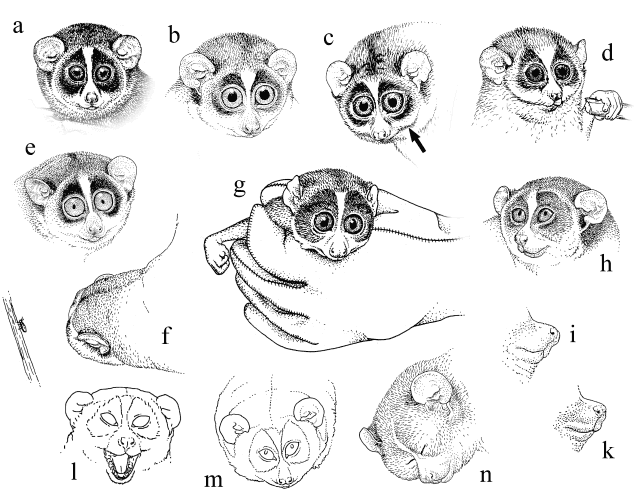
| Home |
|
|
|
Judgement of
wellbeing:
meaning of facial expression in Loris

a, b: Normal expression c, d: Fur gaps in the corners of the mouth, sometimes extending up to the ears (d), often become visible when something unfamiliar is noticed; they probably indicate a certain amount of environmental stress. e, f: The ears can be moved as a reaction to acoustic or other stimuli (e), and ear movements can cause a slight change of ear shape, but it seems doubtful whether ear movements may serve as a signal in communication. Ears laid back can regularly be seen in the initial phase of the prey-catching movement, probably a protective behaviour (f). Ears laid back may also be seen in animals caught and handled (g). In lorises suffering from severe social stress, the ears may be drawn down to the sides of the head, making the face look broader and narrower than usual; expression of social stress may include tense lips (see also k), narrow eyes if the animal is already suffering from unwellbeing caused by dangerous distress, a crouched posture (see figures showing signs of social stress), stay in the low parts of the cage, quiet staring upwards towards the aggressive conspecific or running with apparent flight intention. During severe environmental distress, often wide-open, protruding eyes are shown (g); the animals, however, may also show a rather normal-looking face in spite of apparent distress. i: The lip cleft usually is s-shaped. In stress situations however, particularly during social stress, lips may look tense, pressed together and rather straight (k). l: Open-mouth play face. Such facial expression with the mouth opened more or less widely, sometimes in connection with playful biting, occurs during vivid solitary or social play. Open mouth faces also occur in other contexts, usually in connection with vocalization (see Loris behaviour paper, Schulze and Meier 1995). m, n: narrow eyes may indicate tiredness (in animals disturbed during day); when shown during night, they may indicate weakness or unwellbeing
|
Loris
and related species: health
|
Last
amendment: 10 February
2002
|